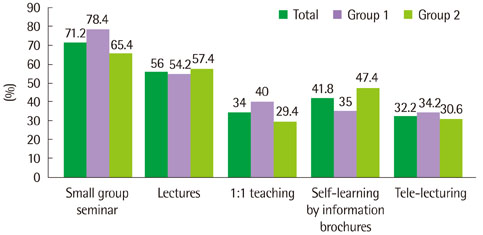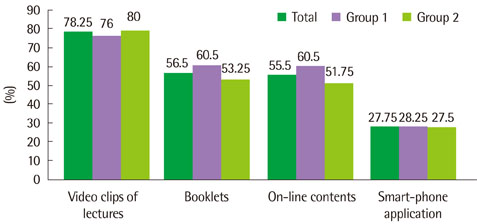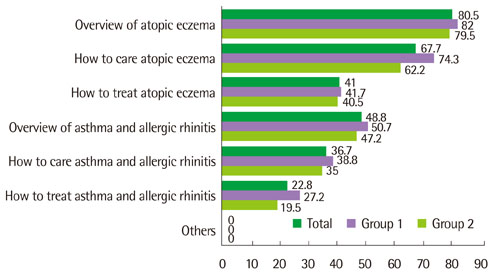Allergy Asthma Respir Dis.
2013 Mar;1(1):55-59. 10.4168/aard.2013.1.1.55.
Educational demand on allergic diseases from 45 public health centers in Gyeonggi-do
- Affiliations
-
- 1Department of Internal Medicine, Seoul National University College of Medicine, Seoul, Korea. addchang@snu.ac.kr
- 2Institute of Allergy and Clinical Immunology, Seoul National University Medical Research Center, Seoul, Korea.
- 3Department of Internal Medicine, Seoul National University Bundang Hospital, Seongnam, Korea.
- 4Gyeongi-do Atopy Asthma Education Information Center, Seongnam, Korea.
- 5Department of Pediatrics, Seoul National University Bundang Hospital, Seongnam, Korea.
- 6Department of Dermatology, Seoul National University Bundang Hospital, Seongnam, Korea.
- 7Department of Otorhinolaryngology, Seoul National University Bundang Hospital, Seongnam, Korea.
- KMID: 2263060
- DOI: http://doi.org/10.4168/aard.2013.1.1.55
Abstract
- PURPOSE
As allergic diseases become common and their socio-economic burden increases, the government needs to develop measures to prevent and manage allergic diseases. Gyeonggi-do Atopy Asthma Education Information Center, funded by the Ministry of Health and Welfare, the Korean Center for Disease Control and Gyeonggi-do, was established in October 2011 to carry out the community-based programs for the patients with allergic diseases in Gyeonggi-do. We investigated the demand on learning, preferred topics and the way of learning about allergic diseases from the public health centers in Gyeonggi-do.
METHODS
From March to May 2012, 54 administrators from 45 public health centers in Gyeonggi-do answered about their educational demand and preferred way of learning and having information.
RESULTS
A total of 52 administrators (96%) from the public health centers answered that they wanted to participate in the education programs on allergic diseases from Gyeonggi-do Atopy Asthma Education Information Center. Forty eight percent of them had learned about allergic diseases at least once previously by lectures, followed by information brochures and by on-line searching. They wanted to learn about an overview of atopic eczema and how to care it, followed by overviews of asthma and allergic rhinitis. They preferred small group seminars with about 10 participants for learning and wanted to have video clips of lectures, followed by booklets for educational materials.
CONCLUSION
This research on the educational demand from the public health centers will be useful in planning the future community-based allergy programs and enhancing communication with the administrators in Gyeonggi-do.
Keyword
MeSH Terms
Figure
Cited by 2 articles
-
Changing Caregivers' awareness on atopic dermatitis
Kyung Suk Lee, Yeong-Ho Rha, Yong-Sung Choi, Sun Hee Choi
Allergy Asthma Respir Dis. 2014;2(2):122-127. doi: 10.4168/aard.2014.2.2.122.Validation of the Korean version of the European Community Respiratory Health Survey screening questionnaire for use in epidemiologic studies for adult asthma
Woo-Jung Song, So-Hee Lee, Min-Gyu Kang, Ju-Young Kim, Mi-Young Kim, Eun-Jung Jo, Suh-Young Lee, Seung-Eun Lee, Min-Hye Kim, Min-Suk Yang, Sae-Hoon Kim, Hye-Ryun Kang, Hye-Kyung Park, Heung-Woo Park, Yoon-Seok Chang, Sun-Sin Kim, Jong-Myung Lee, Kyung-Up Min, Sang-Heon Cho
Asia Pac Allergy. 2015;5(1):25-31. doi: 10.5415/apallergy.2015.5.1.25.
Reference
-
1. Kim YY. Past, present, and future of allergy in Korea. Allergy Asthma Immunol Res. 2010. 2:155–164.
Article2. Park HS, Choi GS, Cho JS, Kim YY. Epidemiology and current status of allergic rhinitis, asthma, and associated allergic diseases in Korea: ARIA Asia-Pacific workshop report. Asian Pac J Allergy Immunol. 2009. 27:167–171.3. Kim YH, Urm SH, Kim WK. Prevalence of allergic diseases and risk factors in preschool children, 2009. Pediatr Allergy Respir Dis. 2011. 21:165–175.
Article4. Clinical Rresearch Center for Chronic Obstructive Airway Disease. The Korean Academy of Asthma, Allergy and Clinical Immunology. Korean asthma management guideline for adults. 2011. Seoul: Clinical Rresearch Center for Chronic Obstructive Airway Disease.5. Jee HM, Kim KW, Kim CS, Sohn MH, Shin DC, Kim KE. Prevalence of asthma, rhinitis and eczema in korean children using the International Study of Asthma And Allergies in Childhood (ISAAC) questionnaires. Pediatr Allergy Respir Dis. 2009. 19:165–172.6. Kim YK, Kim SH, Tak YJ, Jee YK, Lee BJ, Kim SH, et al. High prevalence of current asthma and active smoking effect among the elderly. Clin Exp Allergy. 2002. 32:1706–1712.
Article7. Kim CY, Park HW, Ko SK, Chang SI, Moon HB, Kim YY, et al. The financial burden of asthma: a nationwide comprehensive survey conducted in the republic of Korea. Allergy Asthma Immunol Res. 2011. 3:34–38.
Article8. Cho SH, Kim YK, Chang YS, Kim SS, Min KU, Kim YY. Asthma insights and reality in Korea. Korean J Med. 2006. 70:69–77.9. Lee SW, Lee KE, Park EH, Cho HS, Cha JK, Lee HR. A survey on the use of alternative medicine in allergy patients. Pediatr Allergy Respir Dis. 2001. 11:249–259.10. Chin HW, Jang HS, Jang BS, Jo JH, Kim MB, Oh CK, et al. A study on utilization of alternative medicine for patients with atopic dermatitis. Korean J Dermatol. 2005. 43:903–911.11. Korea Centers for Disease Control and Prevention. Statistics of 7th Korea youth risk behavior web-based survey (KYRBWS) in 2011. 2012. Cheongwon: Korea Centers for Disease Control and Prevention.12. Moonie S, Sterling DA, Figgs LW, Castro M. The relationship between school absence, academic performance, and asthma status. J Sch Health. 2008. 78:140–148.
Article13. Mir E, Panjabi C, Shah A. Impact of allergic rhinitis in school going children. Asia Pac Allergy. 2012. 2:93–100.
Article14. Lim JY, Chung SM, Choung JT. The role of patient and parents education in the management of pediatric asthma. Pediatr Allergy Respir Dis. 2000. 10:51–60.15. Rona RJ, Keil T, Summers C, Gislason D, Zuidmeer L, Sodergren E, et al. The prevalence of food allergy: a meta-analysis. J Allergy Clin Immunol. 2007. 120:638–646.
Article16. Han Y, Kim J, Ahn K. Food allergy. Korean J Pediatr. 2012. 55:153–158.
Article17. Sicherer SH, Sampson HA. Food allergy. J Allergy Clin Immunol. 2010. 125:2 Suppl 2. S116–S125.
Article18. Bock SA, Munoz-Furlong A, Sampson HA. Fatalities due to anaphylactic reactions to foods. J Allergy Clin Immunol. 2001. 107:191–193.
Article19. Lieberman P, Camargo CA Jr, Bohlke K, Jick H, Miller RL, Sheikh A, et al. Epidemiology of anaphylaxis: findings of the American College of Allergy, Asthma and Immunology Epidemiology of Anaphylaxis Working Group. Ann Allergy Asthma Immunol. 2006. 97:596–602.
Article20. Yang MS, Lee SH, Kim TW, Kwon JW, Lee SM, Kim SH, et al. Epidemiologic and clinical features of anaphylaxis in Korea. Ann Allergy Asthma Immunol. 2008. 100:31–36.
Article21. Simons FE. Anaphylaxis. J Allergy Clin Immunol. 2010. 125:2 Suppl 2. S161–S181.
Article22. Johansson SG, Hourihane JO, Bousquet J, Bruijnzeel-Koomen C, Dreborg S, Haahtela T, et al. A revised nomenclature for allergy. An EAACI position statement from the EAACI nomenclature task force. Allergy. 2001. 56:813–824.
Article23. Gomes ER, Demoly P. Epidemiology of hypersensitivity drug reactions. Curr Opin Allergy Clin Immunol. 2005. 5:309–316.
Article
- Full Text Links
- Actions
-
Cited
- CITED
-
- Close
- Share
- Similar articles
-
- Health Promotion and Prevention of Allergic Disease
- An Evaluative Study of Health Education Programs for Community-based Hypertension Control in Public Health Centers
- Educational and Learning Objectives of Schools of Public Health
- A Study on the Job Satisfaction of Visiting Nurses of Public Health Centers in Korea
- A study on the Needs for Nutrition Management Program for Elderly Who use Welfare Facilities




